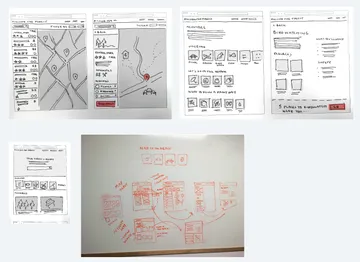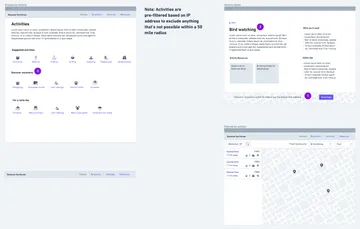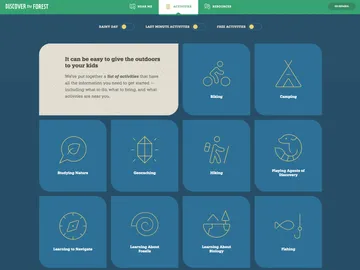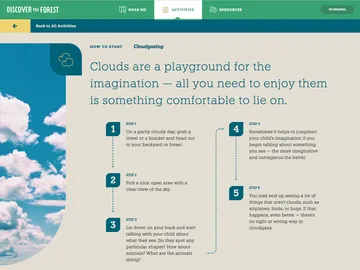Into the Words: Writing for "Discover the Forest"

Elyse Kamibayashi, Former Senior Brand Strategist
Article Category:
Posted on
What is "good content" and how do we write it?
We writers at Viget have a saying, coined by our creative director: People do read online. They just don’t read bad stuff.
But this leads us to the question: what is “good stuff?" And that's where things get interesting.
For digital copywriters, “good” isn’t merely dependent on your ability to turn a phrase. It’s defined, in large part, by your ability to articulate ideas and information in a way that is useful and compelling to a unique audience — one that often has very little time or attention to give. “Good” is about being pragmatic, objective, and wildly imaginative at the same time.
During our work redesigning the site for the Ad Council’s Discover the Forest campaign, Natalie Reich, Ally Fouts, and I spent a lot of time grappling with what good written content meant for our client and our audience.
In the end, we can’t tell you exactly what "good" looks like, but we can tell you what a good approach for getting good content is.
Background: Discover the Forest is a PSA campaign from the Ad Council, in partnership with the United States Forest Service. Its goal is to help families with kids (generally ages 8-12) spend more time outside discovering nature through the National Forests near them. DiscoverTheForest.org was created to be a tool for parents and caregivers who were looking to spend more time outdoors, but needed information on where to go, what to do, and what they needed to bring or prepare.
Step 1: Assemble the team.
Good writing starts with good insights about the challenges that content has to solve, and the audience it’s intended for. You, the writer, simply cannot know everything — and that's okay. At the beginning of the project, the entire team (an art director, UX designer, writer, data analyst, and project manager) got together to analyze the information through the lens of our unique disciplines. It was not only a lot more productive, but it was also a lot more fun.
Step 2: Define a strategy.
Wait, really? You need a strategy to write about fun stuff you can do in the forest?
Yep. While starting to write without a strategy might have been faster, it wouldn't have been as efficient. Writing without a strategy would've meant writing without the answers to questions like: what kind of information do parents need? Why do they need it? How are we going to organize and present it? What kind of tone are we going to use when we do start writing it?
To put it in outdoors terms, writing without a strategy is like being told: "you're going on a hike at an unspecified location. The terrain is unknown, we don't know how long it'll take, but we can tell you that it'll take place during either July or December." Planning, alone, would be a nightmare.
Our strategy was articulated through a simple phrase: “Your Forest is Ready." It contained three promises we made to visitors on the site:
- We’ll help you find an activity or place outside that’s right for you and your circumstances, location, and interests.
- All public lands belong to the public, and they’re there for you to explore and enjoy.
- It doesn’t take a lot of time or money to spend time outside, and we’ll make it easy to wrangle logistics and help you decide what to bring.
Step 3: Define how to reflect that strategy in the presentation and organization of that content.
Remember: strategies are not taglines. A great strategy should be as memorable as a tagline, but it needs to do much more than grab your audience's attention. At this stage, we started to put "Your Forest is Ready" to work. It informed crucial decisions around the structure and content of key pages we knew we would be writing (like the homepage). It impacted the way we displayed "activities" parents could do with their kids. It also influenced our decision to build in a map feature that our audience could use to find forests and parks near them (which also featured important information about the park and what to bring).
Throughout the process, we writers were confident that our writing would be suited to our audience's needs, both in substance and in presentation.



Step 4: Define how to reflect the strategy in the voice & tone — the actual writing — of the content.
Basically, this is when we write.
We knew that our job was to take activities that seem complicated, and break them down into something parents could do without equipment or prep. We saw this as an opportunity to focus on emphasizing the joy of discovering (or rediscovering) the tools everyone already has — curiosity, playfulness, and awareness.
We knew that this needed to be conveyed not just in the information we provided, but also in the way we provided it. With the voice & tone we used, we were careful to strike a balance between sounding joyful and encouraging, and remaining clear, calm, and mature.

In conclusion...
There's another saying we like (this one from Del Close):
“If you treat your audience like poets and geniuses, they have the opportunity to become them.”
When you work in digital, it’s not only difficult to define good content — it’s also hard to remember why good content is so important. Is it about making cool stuff? Is it about selling stuff? Is it about making people’s lives easier?
Adhering to a Close-ian philosophy means believing that it’s our responsibility not to demand genius from our audience, but to provide the opportunity for it.
In other words, we create good content because good content creates good opportunities.
We're proud of our work on discovertheforest.org because, at the end of the day, we were able to help people do something worthwhile.
And, for digital folks, it doesn't get better than that.
Check out the live Discover the Forest site.
I wish I could've done justice to all the incredible work that went into this project. Along with the aforementioned Ally Fouts and Natalie Reich, huge shoutout to Pascale Georges, Emmi Laakso, Owen Shifflett, Megan Zlock, Kate Trenerry, Albert Wavering, and Mitch Daniels.